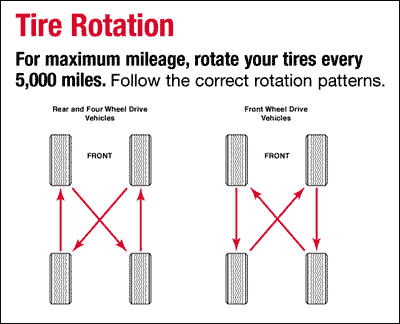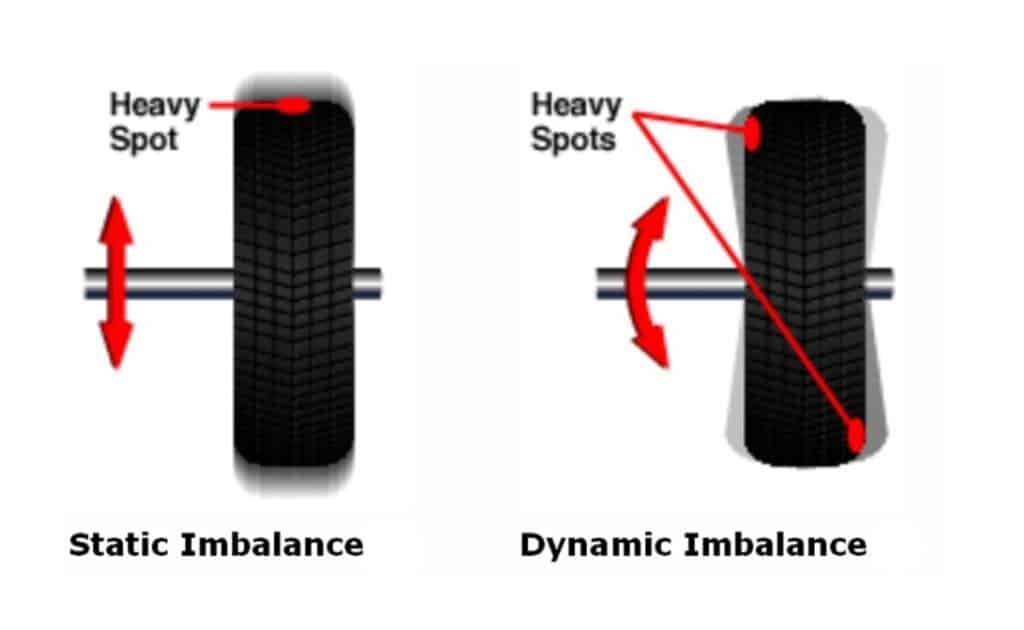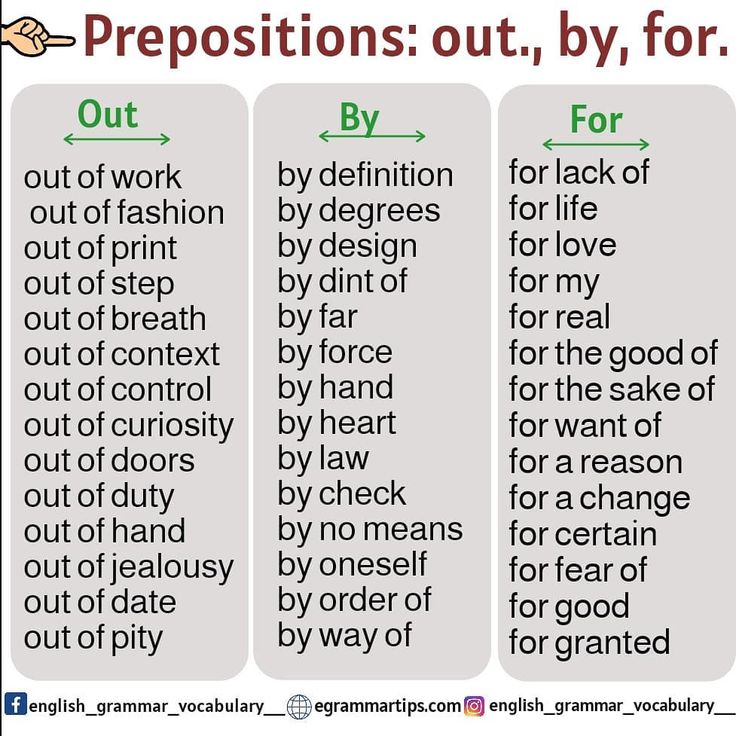The question, "How long does a tire last?" tends to be followed by several others like, “What causes a tire to wear? When should tires be replaced? What can be done to make tires last longer?” Fortunately, we can help provide clarity around these questions.
There is no exact answer to how long a particular tire will last, but there are things a driver can do to get the most out of their tire investment and avoid driving on unsafe tires. On average, people drive between 12,000 to 15,000 miles a year, which means the average good quality all-season tire will last somewhere between three and five years, depending on maintenance, driving style and conditions, etc.
The National Highway Traffic Safety Association (NHTSA) states a driver is three times more likely to be involved in a crash caused by poor tire condition. Safer is smarter when it comes to the health of tires, so if there is ever a question on tread wear or age, have the tires checked.
Multiple factors play a role in how long a tire may remain in service. Miles driven, road conditions, driving style, maintenance and age all affect how long a tire lasts.
Worn vs. Aged
Tires naturally wear the more they are driven and worn out tires provide reduced traction compared to those with adequate tread, especially in adverse weather conditions. Most drivers understand worn out tires (remaining tread depth at or below 2/32”) should be removed from service.
Many drivers are not aware that minimally used tires, like the ones on recreational vehicles, collectible cars, or even spare tires, tend to experience aging instead of wearing, due to a lack of driving. An aged tire has a substantial amount of tread; however, the structural integrity of the tire is weaker because the tire needs to be driven for the chemicals in the rubber to remain effective.
Curbs, Potholes, and Other Hazards
Hitting curbs or driving on roads in poor condition (potholes, broken pavement, poorly graded railroad crossings, unpaved roads, etc. ) can cause misalignment, and suspension damage that affects tire wear. If your daily drive includes these challenges, be sure to schedule annual suspension, alignment and tire checks.
) can cause misalignment, and suspension damage that affects tire wear. If your daily drive includes these challenges, be sure to schedule annual suspension, alignment and tire checks.
Weather Conditions
Driving in poor weather conditions like ice, snow, and rain can cause tires to wear quicker because they must work harder to maintain traction. Purchasing tires that are specially engineered to perform in specific weather conditions can provide drivers with an extra measure of traction and control (meaning greater safety) while delivering good treadwear.
Bridgestone offers different types of tires designed to keep you and your car safe during any weather or road condition. For example, Bridgestone's Blizzak tire series is built to perform in harsh winter weather conditions providing durable traction on snowy and icy roads, and the Dueler tire series is one of several that offer a secure grip on wet road conditions for areas that experience heavy rain.
Poor Driving Habits
Poor driving habits like hard cornering, quick acceleration, and sudden braking can increase the stress on tires tremendously, causing them to wear rapidly. Drivers can extend the life of their tires significantly by avoiding aggressive driving.
Drivers can extend the life of their tires significantly by avoiding aggressive driving.
Neglected Maintenance
It is important to regularly have tires checked for damage, to maintain air pressure levels, and to keep tires aligned and rotated. Without proper maintenance, tire life can be reduced by as much as half - even more, in some cases.
If the below signs are evident with your tires, it may be time to have them replaced.
Low Tread Depth
Tread loss is a significant sign a tire needs to be replaced. Low tread is a sign driver can physically see happening on their tire. Depending on the part of the tire that is wearing, there may be other problems with the vehicle.
Pronounced inner or outer shoulder wear: tires are misaligned
Edge of the shoulder wear: tires are under-inflated, need to be rotated or both.
Center wear: tires may be overinflated or have been subjected to extremely hard acceleration.
Cupped wear: the vehicle is experiencing suspension problems
All tires have tread wear indicators built-in, but if the tread looks low take time to do the penny test on the tires.
Rough Drive
If you’re experiencing a vibration (particularly if it just started), or high (and increasing) levels of tire noise it may be a sign your tires are out of balance, not wearing properly or have a structural issue. In some cases, this may affect safety, so have your tires checked by a qualified professional asap.
DOT Number
The U.S. Department of Transportation (DOT) number on the tire’s sidewall is another way to help keep track of when they need to be replaced. It’s easy to identify - look for the letters “DOT” followed by eleven or twelve letters and numbers. On tires made after the year 2000 the final four digits signify the week and year of manufacture. So, a tire with “3618” would have been made in the 36th week or 2018. A tire that has a 3-digit week-and-year code means the tire was made before the year 2000 and should be replaced due to age.
Bridgestone recommends that its Bridgestone or Firestone brand tires be removed from service after ten years regardless of their remaining tread depth. They also recommend periodic inspections by a qualified technician for damage such as punctures, impact damage, signs of improper inflation or overloading, or other conditions resulting from the use or misuse of the tire.
Tires are both one of the largest maintenance expenses a vehicle owner is likely to face, and one of the most critical in terms of driving safety and performance. For both reasons it’s important to care for them properly. Bottom line: good maintenance and driving habits help keep drivers safe, and it saves them money by extending tire life.
Easy Does It
Tire life can be reduced by as much as half when they’re subjected to a lot of hard braking and aggressive acceleration from a standstill. Avoiding tailgating to reduce the need for frequent hard braking will increase tire life. Easing into the throttle when pulling away from a stop reduces strain on the tires and improves wear. Slowing before sharp corners also reduces stress on tires, as does avoiding potholes and broken pavement when possible. If you’re interested in spending less on tires, following these steps can help.
Easing into the throttle when pulling away from a stop reduces strain on the tires and improves wear. Slowing before sharp corners also reduces stress on tires, as does avoiding potholes and broken pavement when possible. If you’re interested in spending less on tires, following these steps can help.
Regular Maintenance
Another way to extend tire life is to keep up with the proper maintenance of a vehicle and its tires. A couple of things you can do yourself are to check the air pressure and tread depth. You should have a qualified technician periodically check their balance and alignment and be sure to have tires rotated at regular intervals. maintenance is essential for your tires to perform their best and last their longest.
Tires November 3, 2019
If your tires are out of commission, so is your car. Think about it: your tires are your car’s only contact with the road. They need to be in tip-top shape to ensure your safety and the safety of other drivers on the road.
So, how long should tires last? The straightforward answer is “it depends.” A normal set of tires should last for 60,000 to 75,000 miles, or about four to five years. But there are a few key factors that will affect your tires’ lifespan. Keep scrolling to learn more.
How Long Should Tires Last? 6 Factors to Consider:1. The ManufacturerThe average tire on the market is designed to last about 60,000 miles, says Dan Zielinski, spokesman for the U.S. Tire Manufacturers Association, but every tire is different.
“Some tire manufacturers offer a warranty as high as 80,000 miles or more, reflecting confidence in that particular product’s longevity based on its engineering, technology and design. Other tires may be built to provide 30,000 miles of service.”
The type of tires you purchase also plays a role in how long they last. For example, in a study conducted by Consumer Reports, ultra-high performance tires lasted nearly half the amount of miles than family-car tires. Additionally, all-season, summer and winter tires will have different treadwear ratings and, therefore, different lifespans.
Additionally, all-season, summer and winter tires will have different treadwear ratings and, therefore, different lifespans.
Believe it or not, the vehicle on which your tires are mounted plays a role in how long they last.
SUVs and trucks put more weight on tires than a sedan, so if your vehicle isn’t outfitted with the appropriate tires, the tires might wear out faster than expected.
Other times, there isn’t a clear explanation as to why one car model’s tires last longer than another’s. According to autos.com, certain models of the Honda CRV have experienced premature tire wear and damage, increasing the risk of blowouts or accidents on the road.
3. Driving StyleEveryone knows someone who drives like they’re in a real-life version of Mario Kart. These individuals are at a higher risk for prematurely worn-out tires. If you regularly subject your vehicle to hard acceleration, heavy loads, and aggressive driving over speed bumps and potholes, your tires will take a hit.
In addition to driving style, the amount you drive each year also contributes to your tire life. On average, the American driver clocks between 13,000 and 14,000 miles a year, according to the Federal Highway Administration. Some drivers, however, drive much more or less than that.
Did you know that 81% of commuters in Fairfax County drive a car to work? That’s the highest percentage in the D.C. area! So it’s especially important for those of us in Northern Virginia to take care of our tires.
Read: Car Maintenance is Crucial for Northern Virginia Commuters. Here’s Why.
4. Where You LiveIn addition to how you drive and how much you drive, where you drive is another factor to consider when evaluating how long tires last.
Tire wear differs based on the terrain you drive and the region in which you live. Lower temperatures mean lower pressure in your tires, which can result in underinflation, flats and, ultimately, unsafe driving conditions. On the other end of the spectrum, extremely high temperatures cause the pavement to warm up, creating more friction between your tires and the road. The increase in heat emission coming from your tires can be dangerous if they aren’t inflated properly or are cracked or damaged.
On the other end of the spectrum, extremely high temperatures cause the pavement to warm up, creating more friction between your tires and the road. The increase in heat emission coming from your tires can be dangerous if they aren’t inflated properly or are cracked or damaged.
Exposure to sunlight and warmer temperatures also shortens tire life, so tires in warmer, Southern climates tend to require replacement faster.
Regardless of where you live, it’s best to avoid damaged roads, potholes and gravel roads as much as possible. Think about it this way: if it’s best for your safety, it’s most likely best for your tires, too.
5. Maintenance RoutineIf you really want your tires to last, practice proper tire maintenance. Here’s how:
 (The Tire Industry Association recommends getting a tire rotation every 5,000 to 7,000 miles.)
(The Tire Industry Association recommends getting a tire rotation every 5,000 to 7,000 miles.)Read: Tire Maintenance 101: Taking Care of Your Tire
6. Tire AgeNo matter the tread depth, if a tire is more than six years old, you should start thinking about replacement. That’s because the rubber compounds in a tire deteriorate over time, resulting in dry rot. Dry rot makes your tires more susceptible to blowouts and tread separation.
That’s because the rubber compounds in a tire deteriorate over time, resulting in dry rot. Dry rot makes your tires more susceptible to blowouts and tread separation.
Vehicle and tire manufacturers usually recommend replacing your tires if they are 6-10 years old, regardless of tread depth. But for most drivers in Northern Virginia, their tire tread will wear out before the tires get that old.
Don’t forget about your spare! Depending on how old your car is, you could be driving around with a spare tire long past its prime. If the tire is more than 10 years old, replace it.
Ready for New Tires?Bring your vehicle into Virginia Tire & Auto and we can assess the condition of your tires. If it turns out that you need a full replacement, we’ll help you choose the right tires for your vehicle and get you back on the road. You can also find tires using our online tool and schedule an appointment at your convenience.
How to register in the program on the site?
Registration with a membership number is made on the website www. aeroflot.ru in the section "Aeroflot Bonus" - "Join the program" - "Become a member of the program".
aeroflot.ru in the section "Aeroflot Bonus" - "Join the program" - "Become a member of the program".
Fill in all fields of registration data, after the completion of the process a link will be sent to your e-mail address, after clicking on which you will receive a confirmation of registration with the assigned participant number.
Important: When registering in the program, only a unique email address and mobile phone number is used. You will need the answer to the verification question in the future to issue bonuses from your account and to recover your password.
When registering in the program, the system asks for passport data and the validity period of the passport, what validity period should be indicated when entering the data of the Russian passport?
Since the validity period of the Russian passport depends on age and is not fixed, we recommend putting 01/01/2050 or any other date as far as possible from the current one.
What is a temporary card and how can I use it?
A temporary membership card is provided until a permanent plastic card is issued. It contains your unique number in the program. A temporary card can be obtained before registration in the program at the airline office or on board the aircraft and activated on the website in the "Join the Program" - "Activate a temporary card" section.
It contains your unique number in the program. A temporary card can be obtained before registration in the program at the airline office or on board the aircraft and activated on the website in the "Join the Program" - "Activate a temporary card" section.
You can also print a temporary card after completing the registration procedure on the site. To collect miles on your account, you can present it when booking/purchasing an air ticket and when using the services of Program Partners.
How to get a password to enter the Personal Account?
If you registered in the program not through the site, then to create a Personal Account, you must follow the link "Activate a personal account for joint bank cards" and fill out the questionnaire form.
When registering for the program on the site, I made a mistake in my email address and did not receive a link to complete the registration, what should I do?
You need to contact the program's contact center through the "Feedback" window or at bonus@aeroflot. ru with a description of the problem, indicating also your last name, first name and date of birth to search for your membership number.
ru with a description of the problem, indicating also your last name, first name and date of birth to search for your membership number.
Why is a subscription to SMS notification required to access the Personal Account?
Subscribing to this service provides the member with control over his account and, accordingly, the safety of miles in the account. The subscription is carried out with a unique mobile phone number.
The "SMS-informing" service is free of charge. In the "SMS-informing" section of the Personal account account, you can manage the reasons for informing and, if you wish, unsubscribe from those reasons for which you do not want to receive messages. At the same time, the reason for informing about the entrance to the Personal Account is set by default.
Subscribing to SMS notifications requires an answer to a security question that I forgot. How can I restore it?
To restore or change the answer to the verification question, you need to apply to the Aeroflot office with your passport.
Why do I need to get a PIN code?
A personal identification number (PIN code) is required for member authentication, which Aeroflot or Program Partners can perform when earning or debiting miles from a member's account.
How to restore/change the PIN code?
The PIN is not stored in the system. In case of its loss, it is necessary to obtain a new PIN code in your personal account in order to prevent the use of the lost PIN code by third parties. Changing the PIN code is also carried out according to the scheme for obtaining a new PIN code.
How to get a personal plastic card of the Aeroflot Bonus program?
The basic membership card is produced within 2 weeks after earning 2,000 miles on your personal account and is sent automatically to the postal address that you indicated when registering in the program. The card is delivered by Russian Post. Estimated delivery time for the card is 6 weeks.
The membership card is damaged, what should I do to get a new card?
It is necessary to send a written application for making a duplicate of the card through the appropriate section of the "Feedback" window in the Personal Account or on the airline's website, or to [email protected], indicating the place of receipt (Aeroflot office / representative office) or the correct postal address. The application must indicate that the card is damaged. After processing the request, a new card will be made for you within 2 weeks.
At the time of earning 2,000 miles, the postal address was incorrect, and therefore the card was not received. How can I get a membership card?
It is necessary to send an application in free form for obtaining a card indicating the current postal address to Aeroflot Bonus through the appropriate section of the "Feedback" window in the Personal Account or on the airline's website, or to bonus@aeroflot. ru, describing the reason for non-receipt cards. The basic membership card is made within 2 weeks and delivered by Russian Post. Estimated delivery time for the card is 6 weeks.
ru, describing the reason for non-receipt cards. The basic membership card is made within 2 weeks and delivered by Russian Post. Estimated delivery time for the card is 6 weeks.
What should I do if, after registration in the program, I have not received a plastic card after 2 months after accumulating 2000 miles on my personal account?
It is necessary to send a written application in free form indicating the membership number and Last Name / First Name to receive a duplicate card through the appropriate section of the "Feedback" window in the Personal Account or on the airline's website, or to the address [email protected], indicating the place of receipt (Aeroflot office/representative office) or correct postal address. The application must also indicate the reason for ordering a duplicate. The basic card of the participant is made within 2 weeks. Estimated delivery time for the card is 6 weeks.
Aeroflot Bonus card was stolen/lost/damaged, how can I get a new card?
You must send an application for a duplicate card through the appropriate section of the "Feedback" window in the Personal Account or on the airline's website, or to the address bonus@aeroflot. ru indicating the Surname / Name and number of the participant. The cost of issuing a new card is 20 Euros in rubles at the exchange rate used by Aeroflot at the time of payment. Payment is made at Aeroflot offices in Moscow or at Aeroflot representative offices.
ru indicating the Surname / Name and number of the participant. The cost of issuing a new card is 20 Euros in rubles at the exchange rate used by Aeroflot at the time of payment. Payment is made at Aeroflot offices in Moscow or at Aeroflot representative offices.
For participants from 2 to 12 years old, a new Aeroflot Bonus Junior card, as well as Gold and Platinum level cards in case of loss or damage, are made free of charge.
Lost/stolen basic and silver cards upon presentation of a certificate from the police are also produced free of charge.
How do I transfer miles from one of my accounts to another if there is a double registration and both accounts already have miles for flights?
It is necessary to send an application for merging accounts to the program through the appropriate section of the "Feedback" window in the Personal Account or on the airline's website, or to [email protected]. In the application it is necessary to indicate the account numbers, informing the account, which will remain valid. Priority is given to accounts that have been opened earlier, have joint cards with the bank, and also have an elite level. Miles from a closed account will be transferred to a valid account.
Priority is given to accounts that have been opened earlier, have joint cards with the bank, and also have an elite level. Miles from a closed account will be transferred to a valid account.
Consolidation of accounts is made within three weeks after receiving the application in the program.
Received two invoices in the program by mistake. One of my accounts only has signup miles. Will they be transferred?
No. Promotional miles received under promotions not related to flights or the purchase of partner services are not transferred. Miles for flights and miles earned for using the services of program partners are transferred in full.
I have two accounts in the program, they need to be combined, but one of the accounts has a joint bank card, what should I do in this situation?
If the account to which the joint card with the bank is attached remains valid, it is necessary to send an application in any form for merging accounts into the program, indicating the account numbers.
If an account that is not linked to a bank remains a valid account, and the joint account is closed, you must first contact the bank to reissue a joint card to an account that remains active, and then send an application to the program for merging accounts.
When opening a joint card, I receive a refusal, which the Partner Bank motivates by the fact that Aeroflot refused to register. What actions need to be taken to open a joint card?
Opening a joint card is subject to the provision by the Partner Bank of correct personal data, including the participant number. The data obtained is not always correct. The following reasons are possible:
You are already a member of the Aeroflot Bonus program, but you did not indicate it in the application for opening a card, or indicated it incorrectly.
or
The spelling of the Surname and Name in the application for opening a joint card differs from the spelling of personal data in the Aeroflot Bonus program, or the date of birth.
Please contact the bank to check and, if necessary, correct the data: the spelling of the Surname and Name in Latin must match the spelling in the passport. After the changes are made, the bank will re-send the information to the program.
If the spelling of the full name in the program is incorrect, or the date of birth is incorrectly indicated, it is first necessary to correct the data in the program by sending an application through the appropriate section of the "Feedback" window in the Personal Account or on the airline's website, or to bonus@aeroflot. ru, attaching a copy of the passport.
When opening a joint card with the bank, I was assigned a new number. Due to double registration, the account was not activated. Can I merge accounts and keep the account assigned by the bank valid?
The account assigned by the bank cannot be activated. You need to contact the bank to reissue a joint card to a valid account in the program. After reissuing a joint card, it is necessary to write an application to the bank for the accrual of miles received during the period when the card was not active, to a valid account.
Many drivers will have their own opinion on this matter. Some will focus on the requirements of the law, namely the minimum tread depth. Others will say that tires should not be used for more than five years, after which the rubber loses its properties and becomes "wooden". Still others will remember that they read about mileage limits ranging from 40 to 60 thousand kilometers. The fourth will operate only with the amount of money in the wallet.
There is, of course, a very desperate group of motorists. These guys drive to the last and erase the "meaty" tires to the state of a racing slick. Well, individual adepts can be seen rustling spikes on the asphalt in mid-July.
How do you like the rear tires of this Mitsubishi Galant? Whose approach is correct? There is no definite answer, except that the latter pose a serious danger both to themselves and to other road users. Almost all the remaining methods have some logic behind them.
Driving with tires with less than the required tread depth is punishable by a fine. The police rarely pay attention to this, but it is worth keeping in mind the administrative responsibility. So, according to part 5 of article 590 of the Code of Administrative Offenses of the Republic of Kazakhstan, 5 MCI, or 13,890 tenge in 2020, will have to be paid to the treasury. Repeated violation within a year increases the penalty to 20 MCI (55,560 tenge).
The minimum residual tread depth is specified in paragraphs 5.6.1 and 5.6.2 of Appendix No. 7 TR CU 018/2011 "On the safety of wheeled vehicles". The text says that for passenger cars, the balance must be at least 1.6 mm for summer tires and at least 4 mm for winter and marked with signs: M + S, M & S and M S.
Note that measuring the tread depth with a ruler is an extreme step. Almost all modern tires have special wear indicators. As soon as they appear, the rubber should be replaced.
The average life of almost all tires from major manufacturers is 7-10 years, depending on their seasonality. True, such a duration should be expected if a number of operational requirements are met. These include driving on high-quality roads with optimal tire pressure, correctly set wheel alignment angles and a normally working suspension.
True, such a duration should be expected if a number of operational requirements are met. These include driving on high-quality roads with optimal tire pressure, correctly set wheel alignment angles and a normally working suspension.
Tire age can be found by a special marker. The four digits enclosed in an oval (more often found on the inner sidewall) are the DOT marking, in a simple way, the production date. The first two digits indicate the week, and the last two indicate the year of production.
Any of the above parameters can significantly reduce the life of the rubber. For example, with insufficient pressure in the wheel, the side parts of the tread will wear off faster, with high pressure, its middle part. Violations in the geometry lead to uneven tire wear.
The middle part of the tread is worn more. The cause may be excess pressure in the wheelHow and where the rubber is stored is also an important factor. Manufacturers recommend a dry, cool and dark room.

In Kazakhstan, you should not count on more than five years of operation. Nevertheless, one set of wheels can really drive for about ten years. Whether it's worth it is a completely different question. From personal (almost) experience: tires manufactured in one of the CIS countries served from mid-2008 to spring 2018. The annual mileage of the car was small, about 10,000 km per year, including sorties on light off-road. The rest of the tread after all this time would have allowed the same amount of travel, but when one of the tires was removed for repair (the wheel was regularly flattened), the landing board literally crumbled.
Another benchmark for tire replacement is mileage. There are often recommendations on the Web that refer to GOST. Their text says: for passenger cars with a carrying capacity of up to two tons, the service life of tires is 45,000 kilometers.
You can also find references to the operating mileage standards for vehicle tires approved by the Ministry of Transport of the Russian Federation. In them, the average service life varies from 40 thousand kilometers for Russian rubber to 60 thousand for foreign. Note that this document became invalid after the entry of the Technical Regulations of the Customs Union.
In them, the average service life varies from 40 thousand kilometers for Russian rubber to 60 thousand for foreign. Note that this document became invalid after the entry of the Technical Regulations of the Customs Union.
You can also determine how much a tire can run by using the Treadwear (TW) parameter, which indicates the tire wear index. He rarely receives attention. This figure is usually of interest to those who plan to operate the car in a sports environment. Soft and, accordingly, tenacious rubber has a fairly low TW, which racers are guided by.
Surely you have a reasonable question about how the wear resistance index correlates with mileage. TW appeared thanks to the specialists of the National Highway Traffic Safety Administration (NHTSA). To calculate it, the tire at the test site is compared with a special sample, the TW of which is already known.
According to the methodology, the TW100 is equivalent to 48,000 mileage until the tires are completely worn out, that is, Nokian Hakka Green, for example, having a TW400, is capable of serving up to 192,000 kilometers. True, in the real world, wear is influenced by many factors that we talked about above, as well as driving style. Therefore, the results of calculations for TW are recommended to be divided by two. It turns out 96 thousand, or almost 5 years of operation, provided that in the warm season the car drives about 20 thousand kilometers.
True, in the real world, wear is influenced by many factors that we talked about above, as well as driving style. Therefore, the results of calculations for TW are recommended to be divided by two. It turns out 96 thousand, or almost 5 years of operation, provided that in the warm season the car drives about 20 thousand kilometers.
In total, we have three parameters that should help with understanding how long tires will last if they are used correctly, and also tell you when to send a set of tires to the scrap and take care of buying new ones. This can be done on the Kolesa.kz portal using the search form in the "Spare Parts" section.
| | 5.